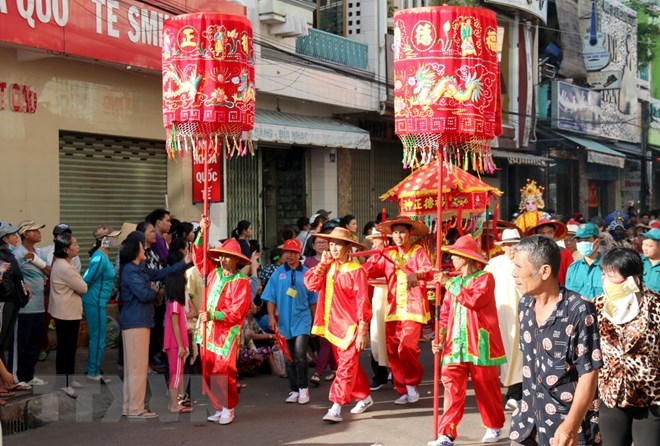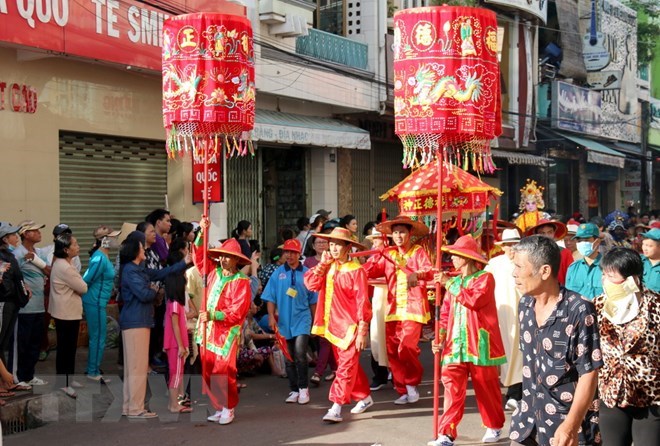
Thousands of locals and tourism flocked to Phan Thiet city, in the south central province of Binh Thuan on September 1 to join the ‘Nghinh Ong xuat du’ ritual, a key part of the biennial Nghinh Ong (Whale Worship) festival.

At the ‘Nghinh Ong xuat du’ ritual (Photo: VNA)
Some 1,000 people masqueraded as the nation’s legends, and
processed Ong’s tablet through the streets of Nguyen Hue, Dinh Tien Hoang,
Trung Trac and Trung Nhi. Stellar dances and martial art performances were
featured during the process.
The highlight of the ritual was the performance of a 49-metre long dragon, the
longest one in Vietnam.
Various traditional rituals were revived at the event, aiming to preserve and
develop the folk culture of the Hoa ethnic community in Phan Thiet city as well
as pray for peace, favourable weather conditions, bumper crop, happiness and
prosperity.
The festival, together with four others, was chosen to serve tourism
development in the province, making contributions to popularising local images
among domestic and international friends.
This year’s event took place from August 30 to September 1.
Phan Thiet city worked to ensure social order, traffic safety, and hygiene
during the festival.
Nghing Ong or Cau Ngu festival is a cultural identity of south central coastal
localities, which has been preserved and passed down through generations. The
festival is to pray for bumper hauls of fish, safe voyages and peace for the
nation.-
Source: VNA
With an increasingly vibrant and widespread emulation movement aimed at building cultured residential areas and cultured families, Yen Thuy District has been making steady progress toward improving both the material and spiritual well-being of its people, while fostering a civilized, prosperous, beautiful, and progressive community.
Once lacking recreational spaces and community facilities, Residential Group 2 in Quynh Lam Ward (Hoa Binh City) has recently received attention for the construction of a new, spacious, and fully equipped cultural house. The project followed the model of state support combined with public contributions in both labor and funding.
The "All people unite to build cultural life" movement, which has been effectively integrated with Kim Boi district’s socio-economic development goals, is fostering a lively spirit of emulation across local residential areas, hamlets, villages, public agencies, and enterprises. In addition, through the initiative, traditional cultural values are being preserved and promoted, while community solidarity and mutual support in poverty reduction and economic development are being strengthened.
A working delegation of the Hoa Binh provincial People’s Committee led by its Permanent Vice Chairman Nguyen Van Toan on June 11 inspected the progress of a project to build the Mo Muong Cultural Heritage Conservation Space linked to tourism services in Hop Phong commune, Cao Phong district.
Born and growing in the heroic land of Muong Dong, Dinh Thi Kieu Dung, a resident in Bo town of Kim Boi district, in her childhood was nurtured by the sweet lullabies of her grandmother and mother. These melodies deeply imprinted on her soul, becoming an inseparable part of her love for her ethnic group's culture. For over 20 years, this love for her hometown has driven Dung to research, collect, and pass down the cultural values of the Muong people to future generations.
In the final days of May, the Ethnic Art Troupe of Hoa Binh Province organized performances to serve the people in remote, mountainous, and particularly disadvantaged areas within the province. These were not just ordinary artistic shows, but they were the meaningful journeys aimed at spreading cultural values, enhancing the spiritual life of the people and contributing to the preservation of ethnic minority cultural identities.



